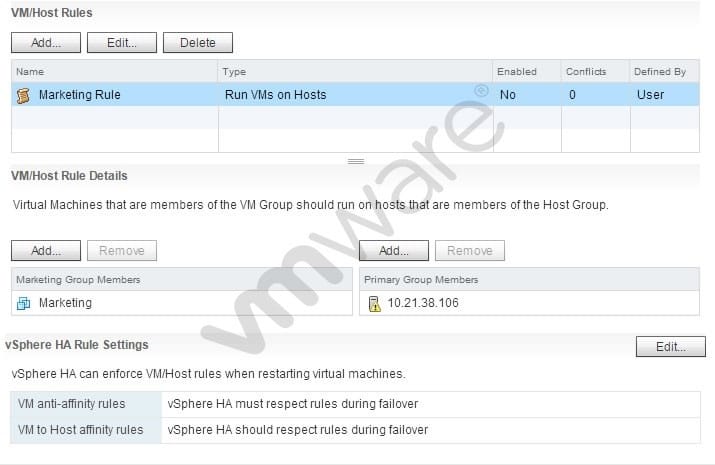Exam Details
Exam Code
:2V0-621DExam Name
:VMware Certified Professional 6 – Data Center Virtualization Delta BetaCertification
:VCP6-DCVVendor
:VMwareTotal Questions
:245 Q&AsLast Updated
:May 06, 2025
VMware VCP6-DCV 2V0-621D Questions & Answers
-
Question 41:
An administrator is building a large virtual machine that will require as many vCPUs as the host can support. An ESXi 6.x host has these specifications:
Six 32-core Intel Xeon Processors 256 GB of Memory 512 GB Local disk space using VMFS5
What is the maximum number of virtual CPUs that the virtual machine can be allocated?
A. 64
B. 128
C. 192
D. 256
-
Question 42:
Which two options are available in the Virtual Machine Component Protection (VMCP) setting Response for Datastore with All Paths Down (APD)? (Choose two.)
A. Issue Events
B. Power off and restart virtual machines
C. Reset virtual machines
D. Leave Powered On
-
Question 43:
An administrator is planning a vSphere infrastructure with the following specific networking requirements:
The ability to shape inbound (RX) traffic
Support for Private VLANs (PVLANs)
Support for LLDP (Link Layer Discovery Protocol)
What is the minimum vSphere Edition that will support these requirements?
A. vSphere Essentials Plus
B. vSphere Standard
C. vSphere Enterprise
D. vSphere Enterprise Plus
-
Question 44:
An administrator wants to configure a High Availability cluster to allow virtual machines a 10 minute window to shut down in the event of a Host Isolation incident. What two configuration settings would satisfy this requirement? (Choose two.)
A. Set the advanced option das.isolationshutdowntimeout = 10.
B. Set the advanced option das.isolationshutdowntimeout = 600.
C. Configure Host Isolation Response to Shut Down and Restart VMs.
D. Configure Host Isolation Response to Power Off and Restart VMs.
-
Question 45:
An administrator wants to set a non-default isolation address of 192.168.1.2 for High Availability. Which advanced setting would accomplish this task?
A. Das.isolationaddress0=192.168.1.2
B. Das.useisolationaddress0=192.168.1.2
C. Das.defaultisolationaddress0=192.168.1.2
D. Das.haisolationaddress0=192.168.1.2
-
Question 46:
Refer to the Exhibit.

A vSphere 6.x DRS cluster is configured as shown in the Exhibit. Based on the exhibit, which statement is true?
A. A virtual machine can be powered on in the Web Resource Pool with a 3 GHz CPU Reservation.
B. A virtual machine can be powered on in the Web Resource Pool with a 4 GHz CPU Reservation.
C. A virtual machine can be powered on in the DB Resource Pool with a 3 GHz CPU Reservation.
D. A virtual machine can be powered on in the DB Resource Pool with a 4 GHz CPU Reservation.
-
Question 47:
An administrator enables High Availability (HA) on a Virtual SAN cluster.
There are four vmkernel port groups with the following IP addresses assigned:
Management: 192.168.12.10 vMotion: 192.168.13.10 Virtual SAN: 192.168.14.10 Fault TolerancE. 192.168.15.10
Which IP address will HA use for traffic?
A. 192.168.12.10
B. 192.168.13.10
C. 192.168.14.10
D. 192.168.15.10
-
Question 48:
Refer to the Exhibit.

An administrator manages a High Availability (HA)/Distributed Resource Scheduler (DRS)- enabled cluster and has configured the affinity rule shown in the Exhibit.
Which two statements best describe the configuration shown in the exhibit? (Choose two.)
A. HA will not failover Marketing to ESXi hosts that are not in the Host Group.
B. HA will failover Marketing to ESXi hosts that are not in the Host group.
C. DRS will attempt to keep Marketing on the ESXi host 10.21.38.106.
D. DRS will not attempt to keep Marketing on the ESXi host 10.21.28.106.
-
Question 49:
An administrator wants to prevent a priority virtual machine that resides in a vSphere DRS cluster from migrating to other hosts in the cluster. What configuration step will accomplish this without affecting other virtual machines?
A. Set VM Overrides to Partially Automated.
B. Set VM Overrides to Manual.
C. Configure a VM/Host Rule with the setting Must run on hosts in group.
D. Configure a VM/Host Rule with the setting Should run on hosts in group.
-
Question 50:
Which two statements regarding Distributed Resource Scheduler (DRS) affinity rules are true? (Choose two.)
A. When two VM-VM affinity rules conflict, the older one takes precedence and the newer rule is disabled.
B. Using Specify Failover Hosts admission control policy, VM-VM affinity rules are not supported.
C. DRS gives higher precedence to preventing violations of anti-affinity rules than violations of affinity rules.
D. It is not possible to create an affinity rule that conflicts with the other rules being used.
Related Exams:
Tips on How to Prepare for the Exams
Nowadays, the certification exams become more and more important and required by more and more enterprises when applying for a job. But how to prepare for the exam effectively? How to prepare for the exam in a short time with less efforts? How to get a ideal result and how to find the most reliable resources? Here on Vcedump.com, you will find all the answers. Vcedump.com provide not only VMware exam questions, answers and explanations but also complete assistance on your exam preparation and certification application. If you are confused on your 2V0-621D exam preparations and VMware certification application, do not hesitate to visit our Vcedump.com to find your solutions here.